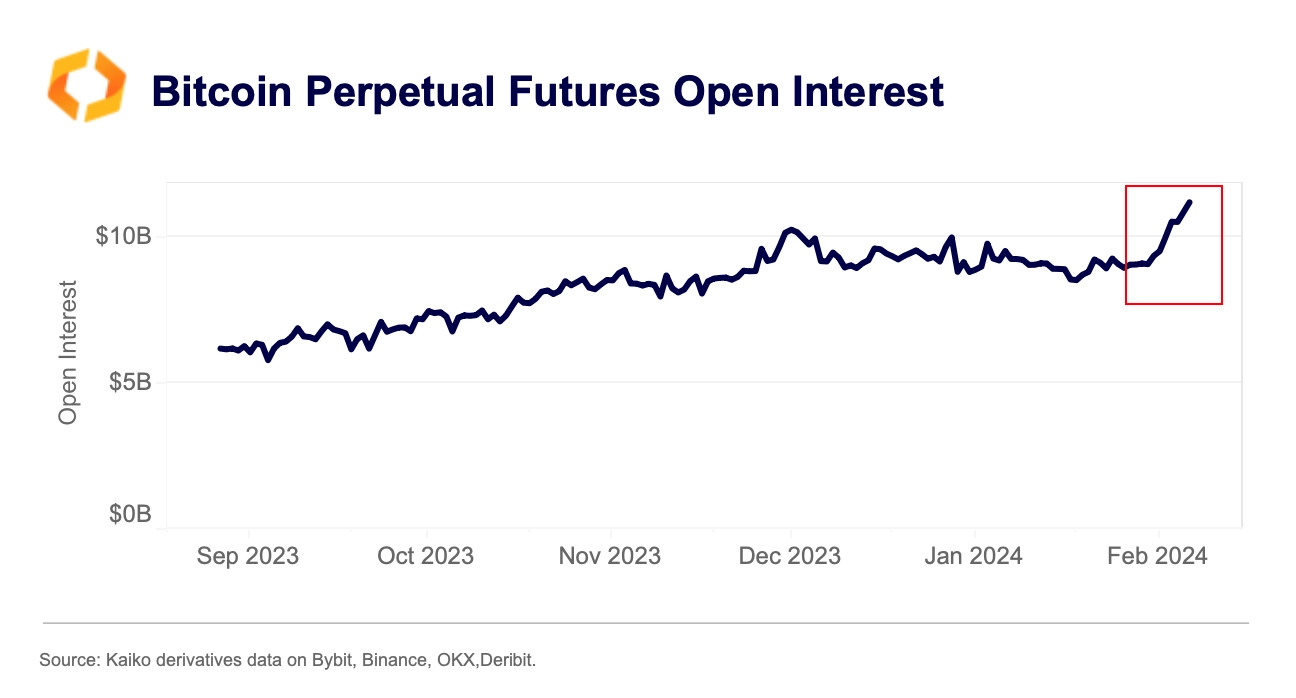

Written by The Kaiko Research Team (All research is powered by Kaiko data.)

Trend of the Week
BITCOIN’S BIG REBOUND.
Bitcoin rallied from $43k to $48k last week, mirroring traditional equities. GBTC outflows more than halved last week relative to the week before, confirming that selling is subsiding.
While GBTC accounted for more than 50% share of overall spot ETF trade volumes between January 11-21, its share has since dropped to around 30%. While outflows are declining, inflows into other ETFs remained robust. BlackRock’s IBIT and Fidelity’s FBTC registered a record first month, while IBIT surpassed GBTC in daily trade volume for the first time on February 7.

Bitcoin cumulative volume delta (CVD) shows that buying outweighed selling around 3pm UTC on February 7, which corresponds to the early U.S. opening hours and was mostly driven by the offshore exchanges Binance and Bybit. On February 8, buying on U.S.-available exchanges intensified, with Bitstamp and Kraken leading the way.
Interestingly, institutional exchanges such as LMAX Digital and Coinbase saw neutral to negative CVD, a sign of continued selling pressure.

BTC perpetual futures open interest also grew last week, suggesting renewed speculative interest. Open interest in USD terms crossed $11bn for the first time since December 2021.

On the flip side, while BTC spot volume spiked, nearing $20bn during last week’s rally, it has since fallen back below $10bn while prices stabilized at $48k, suggesting that the rally needs more support.

Never Miss An Analysis
Get our research twice a week, directly to your inbox.
Data Points
SOL OUTAGE DOES NOT MOVE THE MARKET.

Just a week after we wrote about Solana’s successful Jupiter airdrop, the network experienced its first extended downtime in nearly a year. The downtime was the result of a previously identified bug. However, in yet another sign of strength, SOL’s price barely dipped and has since rallied to hit $110.
SOL and ETH will always be compared, and SOL once again got the better of ETH, with the SOL/ETH ratio bouncing off 0.4 shortly after the downtime before jumping 10%.

The ratio hit 0.056 two months ago, a near all-time high. While ETH’s price has stumbled, activity on the network has been bolstered by the popularity of ERC-404s, which essentially combine ERC-20 (tokens) and ERC-721 (NFTs) standards, creating semi-fungible NFTs.
On the centralized exchange side, SOL continues to show a lower market depth to volume ratio than BTC and ETH.

This has been driven by impressive SOL volume and an ongoing lack of liquidity, especially for altcoins. As discussed in last week’s Deep Dive, this can be a useful metric for assessing tokens and identifying anomalies on exchanges.
XMR PRICE CRASHES AFTER BINANCE ANNOUNCES DELISTING.

The largest privacy token, Monero’s XMR, lost nearly 40% of its value in just a day after Binance announced it will delist the token in February. Privacy tokens are designed to obscure transaction details. While data on their usage is scarce, rising regulatory scrutiny has pushed major exchanges to delist them over the past few years. In early January, OKX delisted several privacy tokens trading pairs while Binance placed XMR under monitoring.
Market makers also reduced their exposure, with XMR liquidity — as measured by 1% market depth — falling to an all-time low of $1.8mn last week. The decline was broad-based, with Kraken registering the strongest drop of nearly 50%, followed by Bitfinex and Binance with 35% and 31%, respectively.

While Binance’s market share of global XMR volume has declined significantly over the past year, from 63% to 30%, the delisting will likely have a negative impact on XMR trading and liquidity.
BITHUMB SURPASSES UPBIT ON RISING BTC VOLUME.
Bithumb briefly became the largest Korean exchange by trade volume in early February amid soaring BTC trading. Its market share of volume relative to its main rival Upbit hit an all-time high of 72% on February 4 before falling back down to 34%. This trend is remarkable considering South Korean exchanges have the largest altcoin volumes in the world relative to BTC.

BTC-KRW trading on Bithumb has exploded since the end of December, despite zero fees launching months ago. In January alone the exchange facilitated $21bn in BTC trading which is more than the combined BTC trade volume during this month in the past three years. The daily BTC-KRW volume on Bithumb has exceeded the most liquid BTC trading pairs on both Binance and Coinbase multiple times since late 2023.

While Bithumb has emerged as the largest Bitcoin market in South Korea, its BTC market share has been volatile, varying from 50% to 90% over the past month and a half.